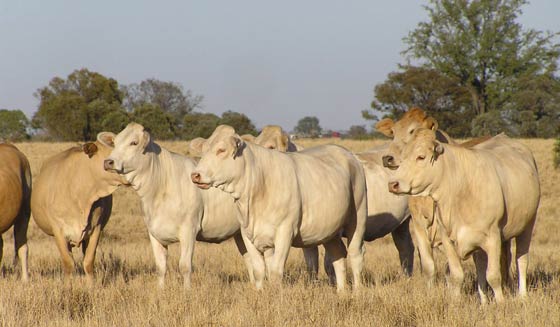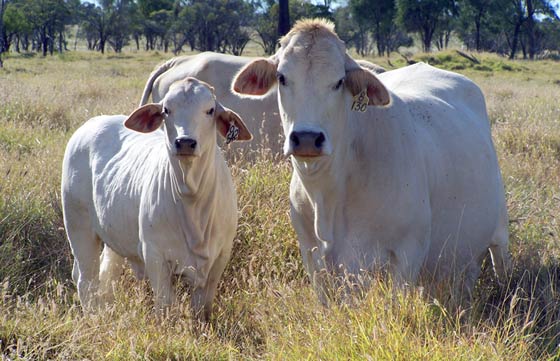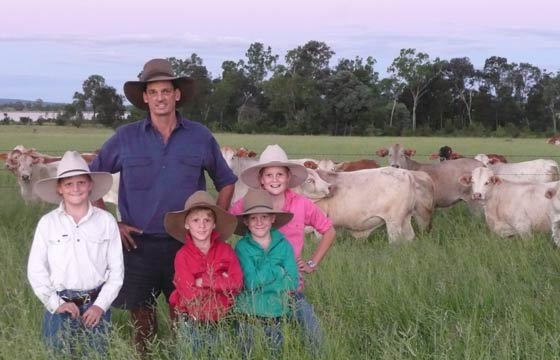CHARBRAY TESTIMONIALS
McKeering Family - Testimonial - September 2011
Charbray Bulls lift average turnoff weight
By Penelope Arthur
THE use of Charbray bulls in their Brahman based herd has enabled Alpha district graziers, the McKeering family, to better target the Jap Ox market.
The McKeering family run 3500 high grade Brahman breeders across two properties on the Belyando River in the Alpha district, aiming to turn steers off direct to works at 340kg dressed with three teeth. Cull heifers are usually sold with two-teeth and dress around 285kg.
The family business includes Ross and Matthew McKeering and their respective wives, Sandy and Sally. Ross McKeering said the family made the decision to introduce Charbray bulls nine years ago, in an effort to “add extra bone and weight” to their cows and progeny.
“It has definitely added extra weight to our cows which we know is being passed on to the steers and cull heifers,” he said.
“Using Charbray bulls has definitely lifted our average turnoff weight considerably and helped us to fit the grid better than we were when we were running straight Brahmans.”
“We also keep a large number of the Charbray cross heifers, particularly the smoother type heifers and they have proved to be very good cows.”
The McKeering family have purchased many of their Charbray sires from the National Charbray Bull and Female Sale in Rockhampton and are hoping to attend the 2011 sale later this month. Mr McKeering said he aims to buy bulls with a strong Brahman influence.
“Temperament is also a big thing for us but most of the breeders seem to be on top of that now days and no one really puts those bulls up for sale any more,” he said.
“We’ve found the National Sale to be a good venue to buy bulls because most of the large vendors are there and most times we can find the type of bull we are looking for.”
The McKeering family have worked hard to reduce the distance between waters on their vast western Queensland properties, with most cattle required to walk less than 3km to find a drink.
“We are pretty well watered and I don’t think our bulls have to travel much further than bulls on other properties but, being a large scale property, the bulls and cows do have to cover a fair bit of ground,” he said.
“The Charbrays have proved they have no trouble handling our conditions – we join all year round and they just get out there and do the job.”
Commercial Reality - September 2011
Producer at a Glance
Name: Mick and Karen Nobbs
Location: Mount Vexation, 160km southwest of Springsure
Herd size: 1500 breeders
Rainfall: 700mm
Target market: Predominantly MSA
Commercial Reality
By Penelope Arthur
A strong focus on selecting and breeding Charbray bulls with adequate fat cover is helping Springsure beef producer Mick Nobbs produce progeny that consistently grade well under Meat Standards Australia (MSA).
Operating in conjunction with his wife Karen and their children, Michael, Russell, Howard and Penny, Mr Nobbs runs 1500 Brahman and Charbray breeders on their 17,000ha home property, Mount Vexation, 160km southwest of Springsure. The family also own another breeding property in the Sarina district where they run an additional 1500 Brahman and Charbray breeders.
Mr Nobbs said the family will vary their marketing according to seasonal conditions and current prices but generally aim to finish their steers and cull heifers at over 300kg dressed for the MSA market. He said his Charbray progeny have consistently proved they are well suited to the premium market.
“We’ve only been targeting MSA for a short time but we have learned that the ability of the Charbray’s to lay fat cover down certainly helps them fit that market,” he said.
“We sometimes sell a few weaners through local shows or through private sales and this year we sold a line of Charbray heifers privately to a backgrounder in our local area who intends to grow them out for the MSA market.”
Mr Nobbs said he’ll also target the feed-on market if feedlotters are offering attractive rates.
“When the money is good we’ll sell direct to feedlots – usually to the Smithfield Feedlot at Proston,” he said.
The Nobbs family began breeding Charbray cattle after introducing Charolais genetics to their Brahman herd in 1988.
Mr Nobbs said he initially sold all Charbray progeny but soon came to realise the potential in keeping the Charbray breeders. He now uses his own Charbray bulls as well as buying sires each year at the National Charbray Bull and Female Sale.
“We’ve been impressed by the fertility and the fat cover in our Charbray herds,” he said.
“When buying bulls we look specifically for bulls with that extra fat cover and with our females we try to select cows with good fertility milk traits and fat cover as well.”
The Mount Vexation herd is seasonally mated with bulls introduced to the herd from October to May. All cows are pregnancy tested annually with any that don’t present a calf at either branding or weaning culled.
“We also join our heifers at around 18 months of age and achieve pregnancy rates of around 75pc in our heifers,” he said.
The quality of the Nobb’s Charbray weaners has been tested at several store competitions over the past decade. Some of their most notable achievements including winning Champion Pen of Store Steers and Reserve Pen of Store Steers at Beef 2000.
“That year at Beef we were named the Most Successful Exhibitor,” Mr Nobbs said.
“We’ve also won a few local shows such as Springsure and AgGrow at Emerald.”
“This year at Emerald we won third in the steer competition and second in the heifers with our Charbray weaners.”
“We think participating in these local shows is a good way to support our local shows while also comparing the quality of our cattle to others – it gives us a good idea of how our breeding program is going.”
Charbray focus evolves at Huntington – September 2011
Charbray focus evolves at Huntington
By Penelope Arthur
AS Queensland beef producers begin to recover from almost a decade of drought, many are reflecting on the lessons learned during those lean, hard years. Many may never fully recover, but some, like Taroom beef producer Matt Welsh, believe those drought years have ultimately made his family’s beef business more viable.

Charbray Cows have literally transformed the Huntington operation through their sheer weight of performance in the paddock
It was during the drought of the mid to late 1990s that the Welsh family came to realise the full potential of their Charbray breeders. The family had started breeding Charolais bulls in the early 1980s to use as terminal sires over Brahman cows but began keeping their Charbray heifers after encountering difficulties sourcing quality replacement females. As the drought set in, the Charbray cows began to outperform the purebred Brahman and Charolais females, as well as the first cross cows, producing more calves and requiring less inputs to get those calves to weaning.
“The Charbray cows literally forced their way into our paddocks,” Mr Welsh said.
“They were the cows having calves every year despite the drought and, at the end of the day, calves on the ground is the main profit driver of any breeder operation.”
“It might have been hard to live through but that drought definitely made our breeder herd more accountable.”
“It opened our eyes to the potential of the Charbray breed and that revelation has been instrumental in making our entire operation more profitable.”
Confirmation of the benefits of breeding Charbray cattle has meant a subtle shift in focus for the Welsh family business, the Huntington Charolais and Charbray Stud. Although the origin of the Huntington Stud lay in breeding Charolais bulls, Matt says the performance of their own herd has meant a growing focus on Charbray genetics. The family business owns several breeding and fattening properties in the Taroom district and runs around 1000 commercial and stud cows. Working alongside Matt is his wife Rachael, brother, John, parents Pat and Laurie, and brother and sister-in-law, Luke and Keryn.
The Huntington Stud sells bulls at an annual spring bull sale in Taroom and an autumn sale at Winton. Bulls are also available privately out of the paddock. Any surplus commercial steers are sold as feeders into a network of local grass finishers while most surplus heifers are sold to repeat buyers as replacement breeding stock or as feeder heifers to backgrounders for the feedlot sector.
In their own herd, the use of Charbray bulls over Charbray females has delivered consistency and predictability. Matt said there was a common perception among producers that Charbrays were just a mixture of Charolais and Brahman blood — that anyone with one of each parent breed could easily produce a Charbray.
It’s a misconception that he is keen to dispel.
“There are so many people that think they can’t breed past their first cross,” he said.
“Our experience has overwhelmingly been that by stabilising our Charbray herd, we could move away from the trait variation that using the two parent breeds gave us, which in turn delivered increased progeny predictability.”
“There will always be a top line of animals you really love in your first cross but you can also get a fair tail in the same drop of calves.”
“We’ve found it’s far more profitable to reduce the tail in our herd through better predictability by using good quality Charbray bulls.”
Despite being a stud operation, Matt says it is business as usual on their breeding properties. The cows are generally joined from November through to March or April and the entire herd is pregnancy tested annually. Mr Welsh said there was generally a 5pc drop from pregnancy rate to weaning rate, which was currently hovering around 87pc.
“The fact that our Charbray cows have superior fertility is so clearly highlighted at weaning time,” Mr Welsh said.
“They have just overtaken the herd – through sheer performance the Charbray cows have commanded the majority of our breeder space.”
Matt said the family had been able to reduce their supplementary feeding bill in recent years and attributes that to the performance of the Charbray breeders.
“With a realistic stocking rate and a larger number of Charbray cows in the herd we have seen a notable decline in our supplementary feeding costs but better performance in the cows at the same time,” he said.
“We do think it’s very beneficial to look after the weaners well and we also yard wean and handle them regularly throughout that process.”
Now in his third year as the President of the Charbray Society, Matt’s been amazed with the speed at which Charbray cattle have come to the fore in his own business. He said being able to see results in his own herd had galvanized his passion for the breed.
“It’s been an interesting process and we’ve learned a lot of lessons along the way but the sheer demand for Charbray cattle and the potential that we see in our own herd has really driven the breeding program at Huntington,” he said.
Bauer Family - Tambo & Stonehenge - Testimonial - April 2011
Producer at a Glance
Name: Bauer family
Location: Greendale, Tambo and Glenariff, Stonehenge
Herd size: 400 Stud Brahman breeders & 1200 commercial Brahman and Charbray breeders
Rainfall: Tambo 475mm. Stonehenge 275mm
Target market: weaner market
Charbray meet the market at Tambo
By Penelope Arthur
Matt Bauer has a simple philosophy when it comes to running a beef operation.
“We just try to breed cattle that suit today’s market while also keeping our overheads down,” he said.
“Breeding Charbray cattle allows us to cater for the many buyers who prefer Charbray’s while running Brahman breeders helps us keep our costs to a minimum.”

Working in partnership with his wife Amanda and parents, Graham and Roslyn, Mr Bauer runs stud and commercial cattle on the 15,000ha home property, Greendale, 20km north west of Tambo, and the 56,700ha Glenariff, 25km south of Stonehenge on the Thompson River.
The Bauer’s run 400 purebred Grey Brahman breeders, selling around 100 bulls out of the paddock each year under the Grampians-Amaroo Stud name.
They also run 1200 commercial breeders including 400 Charbray cows and 200 cows with a Charbray influence. The balance comprises Grey Brahman breeders.
The Bauer family have been breeding stud Brahman cattle since 1961 and introduced Charolais bulls to the herd in the early 1980s to inject some hybrid vigor into the breeding program.
“We had tried a couple of other Euro breeds to try and get some hybrid vigor into the herd but in the end we found the Charbray progeny were the stand out,” he said.
“We find the Charbray cows very fertile and they have good longevity,” he said.
“The vast majority of the Charbray cows have produced calf after calf and been very dependable money earners for us.”
Working on a 12-month joining, the Brahman breeders are joined to Brahman and Charolais bulls while Charbray cows are joined to Santa, Droughtmaster, Shorthorn and Charbray bulls.
The herd are pregnancy tested annually to ensure high fertility is maintained.
“The herd at Greendale generally achieves pregnancy rates of 90-95% while at Stonehenge we get around 85-90%,” Mr Bauer said.
“We also don’t supplement the breeders at Greendale although we do supplement with phosphorus at Stonehenge where it is needed.”
All suitable female Charbray progeny are retained while the rest are sold off their mothers as weaners.
Mr Bauer said the Charbray weaners attract strong interest from the buyers every year.
“We sell them privately, out of the paddock, usually the same three or four buyers every year,” he said.
“That allows us to follow up with the buyers and get valuable feedback on how they are performing.”
“We could sell as many Charbray replacement heifers as we wanted – we are always getting calls from people looking for Charbray heifers.”
“The Charbray steers are also very popular with the buyers – the Charbray gives then that extra weight gain while the Brahman influence ensures adequate fat cover on the bullocks as well.”
The Bauer’s have been selling their steers and cull heifers as weaners for around eight years and say it’s been a worthwhile marketing strategy.
“We aim for weights of around 270-330kg live off the cow,” he said.
“This year we got $720/head for the weaners which was exceptional but usually we get at least $600/head and we just feel that you can’t go past that sort of money.”
David and Ruth Edwards - Sainsbury Park - Testimonial - April 2011
Charbray’s handle Theodore wet
By Penelope Arthur
IT’S been too wet on David and Ruth Edward’s Theodore property, Sainsbury Park, for them to do much to help their Charbray breeders through one of the wettest years on record.

David Edwards looks and a line of his Charbray weaners with his children Annabel and Douglas and twins, Ryan and Martin
The 2846ha property, 50km west of Theodore, received twice its average annual rainfall in 2010, with a staggering 56 inches falling over the year. Much of that fell in early summer (20 inches), causing a massive sand fly wave unlike anything the Edwards family had seen on Sainsbury Park.
The big rain also caused major damage to fencing although the Edwards’s say they were lucky to escape the major flooding that hit their home town. And despite the added pressure from sand flies and boggy conditions, Mr Edwards said his Charbray breeders have continued to produce calves and have coped with the big wet very well.
“The calves are still hitting the ground and that’s the main thing,” he said.
“This was only the second time in my life that we’ve had sand flies but because it was too wet to get around the cattle have just had to look after themselves.”
“Everything looks fat and content now and we are overdue to do a brand and wean so we’re happy with that.”
The Edward’s family run 450 commercial Charbray breeders on Sainsbury Park and aim to sell their steer and cull heifer progeny into the EU market. A second generation cattleman on Sainsbury Park, Mr Edwards said his family started using Charbray genetics in 1989 and have been thrilled with the results.
“We always thought we might eventually move to another cross but it’s got to the point now that we are meeting the specifications for the EU market so well with our Charbrays that we have never been game to use any other breed,” he said.
“We are very pleased with the added weight we get with the Charbrays and the fact they meet the EU specs so well.”
The Edwards family usually sells finished cattle direct to works but say good premiums being paid for EU store cattle have made the feeder market look more attractive in recent months.
“We always sold direct to works until 18 months ago when we started selling feed-on steers,” he said.
“Since they introduced that EU grainfed market it’s made selling steers a bit earlier a lot more attractive.”
Mr Edwards joins his bulls all year round and aims to source his Charbray bulls from a variety of studs.
Over the years they have used bulls from most of the major Charbray breeders including Huntington and Greenfields.
Click here for 2014 Testimonials
Click here for 2013 Testimonials
Click here for 2012 Testimonials
Click here for 2011 Testimonials
Click here for 2010 Testimonials
Click here for 2009 Testimonials
Click here for 2008 Testimonials



